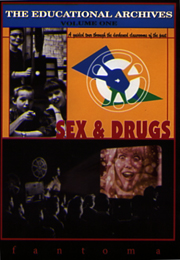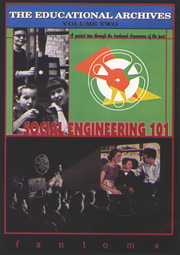| Release List | Reviews | Price Search | Shop | Newsletter | Forum | DVD Giveaways | Blu-Ray/ HD DVD | Advertise |
| Reviews & Columns |
|
Reviews DVD TV on DVD Blu-ray International DVDs Theatrical Reviews by Studio Video Games Features Collector Series DVDs Easter Egg Database Interviews DVD Talk TV DVD Talk Radio Feature Articles Columns Anime Talk DVD Savant HD Talk Horror DVDs Silent DVD
|
DVD Talk Forum |
|
|
| Resources |
|
DVD Price Search Customer Service #'s RCE Info Links |
|
Columns
|
 |
Sex & Drugs |

|
Sex and Drugs Fantoma / Image 1941-75 / mostly color / 1:33 flat / ? m. / 12 educational films DVD Credits: Menu and Package Design Derrick Scocchera DVD Curator Skip Eisheimer Produced by James Healey, Ian Hendrie, Derrick Scocchera |
LSD: A Case Study (1969 Lockheed 4 min) This is the bizarre picture where an acid-tripping woman thinks a hot dog has turned into a talking troll that screams when bitten! Very disturbing. The print has faded red; in this 'case study' series, psychedelic light-show patterns are superimposed over still images.
Human Growth (1962 EC Brown Trust 12 minutes condensed) One of the better-produced films; the print is marred by big green scratches. Puberty and hormones are the subject; with adorable school kids. Good animation substitutes for graphic views of body parts.
Narcotics: Pit of Despair (1967 12 min excerpt) A hopeless and unconvincing "trapped in the drug spiral" saga, with Kevin Tighe snared into a pot party run by a conniving pusher. His moll seduces our hero like Natasha in Rocky & Bullwinkle.
Know for Sure (1941 13 min condensed) A real oddity, a Hollywood production with classy production values starring unbilled J. Carroll Naish, Tim Holt and a really dopey Ward Bond as hapless syphilis carriers. Samuel S. Hinds (the Dad from It's a Wonderful Life) is the doctor who dispenses the bad news. A must-see for Camp value.
Barbituates: A Case Study, Heroin: A Case Study, Amphetamines: A Case Study (1969 Lockheed 2, 4 & 3 min) use the animated stills & testimony format as discussion starters. The heroin short gets heavy fast, with the narrator locked in a jail ward in hellish torment. As the notes point out, all of these use the kind of psychedelic images normally associated with LSD movies.
It's Wonderful Being a Girl (1968 17 min condensed) A wonderful non-pro girl does a great job opposite a stiff mom while learning how to fold a feminine napkin. At this point Savant bailed. Why does this make me more uncomfortable than movies about cruelty or terror?
Marijuana (1968 22 min.) Sonny Bono does indeed look really high in a cautionary tale that claims that grass is the first step to doom. I can testify that in my high school this picture just confused straights like me, while the hipsters laughed their heads off.
Social-Sex Attitudes in Adolescence (1953 McGraw-Hill/Crawley (Canadian) 17 min condensed B&W) Lorne Greene's narration is unexpectedly funny in this well-produced, earnest, and frank discussion about how being raised right prepares people for marriage. Good cute kids, stiff adults. In one unexpectedly mature scene, a mom finds dirty drawing in her son's notebook. Two unmarrieds making out is presented without being condemned out of hand. For 1953, that's progressive.
LSD: Insight or Insanity (1969 15 minutes condensed) This is the nadir of the drug film, deadly when it was inflicted on us in school and soporific now. Boring doctors talk, Sal Mineo is obnoxious, and the kids and pushers are the only humans in sight with whom one can relate.
The ABC of Sex-Ed for Trainables (1975 20 min) A film with the impact of Freaks. It's meant to guide teachers in mental institutions, who must try to train (not teach) those patients considered 'trainable', to know enough about their bodies and sex to neither be anti-social nor victimized in public. A sobering problem is addressed directly. A counselor coaches teachers in all the other names for a penis; any way of communicating with these unfortunate patients is to be seized upon. A harsh but honest narrator talks rough (to weed out the prudes among prospective teachers?) and shows some very dedicated teachers taking on a really tough job. Reenactments stress how sexual predators can prey upon the mentally impaired; the scenes with the real patients are disturbing but also full of hope. Challenging stuff, but very worthwhile.

|
Social Engineering 101 Fantoma / Image 1947-72 / color & b&w / 1:33 flat / ? m. 10 educational films DVD Credits: Menu and Package Design Derrick Scocchera DVD Curator Skip Eisheimer Produced by James Healey, Ian Hendrie, Derrick Scocchera |
Lunchroom Manners (1959 Coronet 10 min) We're informed that this short became famous by being featured on a Pee Wee Herman HBO special. A Puppet called Mr. Bungle shows right and wrong behavior to kids, with child Psych logic that hopefully was more effective when the movie was new. Scenes showing the children of 1959 are heartwarming, however.
Soapy the Germ Fighter (1951 Avis Films inc 10 min) Strictly for tiny tots and surreal beyond words. A giant talking bar of soap lectures a kid on hygiene. Make a schizophrenic Acid-tripper watch this film, and he'd go nuts permanently.
Appreciating our Parents (1959 Coronet 10 min. Color) A kid learns what parents do to make the family function. It says a lot about our culture when 6-year-olds and parents are so alienated that an instructional film is required to bridge the gap. A miniature masterpiece.
Shy Guy (1947 14 min) The familiar short with young Dick York gawking and geeking while working up the nerve to speak to people. He breaks the ice through his interest in radio! 1947 kids get together to sing "Oh! Susanna!" around the piano? Mike Wallace narrates.
Why Doesn't Cathy Eat Breakfast? (1972 National Dairy Council 4 min) This trendy-looking short subject has a nicely chosen, ethnically dark main actress but remains rather confusing. An image of milk is never more than three shots away.
Right or Wrong? (1951 Coronet 10 min, Color) This is the quasi-noir show about making moral decisions. The print is in very good shape.
Personality & Emotions (1954 Encyclopedia Brittanica. 13 min. B&W) Basic child psychology well illustrated with cute kids. The dynamics of siblings in conflict is so well displayed that a tot who cries in frustration gets our full sympathy.
Why Vandalism? (1955 Encyclopedia Brittanica 16 min. B&W) Bruno Bettelheim, Phd. is the academic brains behind an expressive drama that lays out the formula for every theatrical Juvenile Delinquent picture to follow. The hero is a Frankenstein-Lenny figure who relates to animals but not people. The script stresses that nobody is typical, and then ends with an annoying liberal lecture about parental responsibility. Great malt shoppe scene: one kid nervously tears a seat cushion while another bends silverware into knots. These guys would take James Dean apart.
Manners in School (1959 McGraw Hill Centron 10 min) A sass-mouthed school bully (a really bad tyke actor) learns social consciousness from a talking chalk drawing called (guess) Mr. Chalky. Good example of propaganda that couldn't possibly have worked. Ends with a list of rules that sound like RoboCop's prime directives.
The Outsider (1951 Young America films 12 min) Great (and early) tale of youthful alienation, with an introverted, adorable teen girl terrified of her peers. The rest of the cast have charming southern drawls.
Fantoma has done a respectful job compiling these discs, mainly by not stressing their camp value (take that, Rhino). The packaging design and presentation evoke the 16mm classroom projection experience, with an A/V training film used for the menu motif. The notes accompanying the shorts say which ones have been cut down, or only found as fragments, and the liner notes on the paper insert are appropriately on topic. The transfers of the films are fine, and although a couple are heavily worn, the source quality overall is quite good. An added extra is a filmstrip about Fear, that I think President Bush should use the next time he addresses the nation.
When Fantoma continues with this line of discs Savant shudders at the possibilities: industrial safety films ("My eye! My eye!" yeesh!) and driving safety films ("And you could end up looking like this!"). These two collections rate an A+. Good show.
On a scale of Excellent, Good, Fair, and Poor,
Sex and Drugs rates:
Movie: Excellent
Video: Good, although the quality of the short subjects ranges from okay to really beat-up
Sound: Good
Packaging: Keep case
Reviewed: November 13, 2001
On a scale of Excellent, Good, Fair, and Poor,
Social Engineering rates:
Movie: Excellent
Video: Good, although the quality of the short subjects ranges from okay to really beat-up
Sound: Good
Packaging: Keep case
Reviewed: November 13, 2001
Footnote:
1. I remember all the girls being marched out of our 6th-grade class and returning with bags of mysterious handouts. They then behaved as if they'd been initiated into some elevated state of consciousness. We boys stayed behind and were forced to watch some idiot hygiene film about taking showers and blowing our noses.
Return
2. Savant discussed an offensive drug propaganda film in depth in a review of Something Weird's Mantis in Lace; none of the Fantoma films are anywhere near as unpleasant as the ones included on that disc.
Return
Review Staff | About DVD Talk | Newsletter Subscribe | Join DVD Talk Forum
Copyright © MH Sub I, LLC dba Internet Brands. | Privacy Policy | Terms of Use
|
| Release List | Reviews | Price Search | Shop | SUBSCRIBE | Forum | DVD Giveaways | Blu-Ray/ HD DVD | Advertise |





